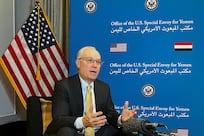The walls of Mohammed Afkhami’s Dubai residence are lined with works by every star of Iranian contemporary art.
A Swarovski-covered Farhad Moshiri canvas hangs above his sofa – he bought the piece titled One World-Yek Donia in 2007 for US $601,000 (Dh2.2 million) – more than seven times its estimate, and the highest price ever paid for a Moshiri work. In the corner, sits an unusual sculpture by Monir Farmanfarmaian – an octogenarian who has had a meteoric rise to fame in the past decade.
Nestling in a beautifully lit alcove is a painting by Reza Derakshani, whose skill with layering texture and meaning are clearly evident.
These are just a few examples from the investment banker’s comprehensive collection, which totals about 600 pieces of mostly contemporary Iranian art, with a spattering of some of Western greats and antiquities.
Afkhami is one of the primary collectors of art from his native Iran, and pieces from his collection form an exhibition, Rebel, Jester, Mystic, Poet: Contemporary Persians, which opened at the Aga Khan Museum in Toronto this month and will be on display until June 4.
He comes from a creative family. His great grandmother was the founder of the first Iranian art institute for women in the 1930s, and his grandfather was a collector of Persian Islamic art and antiques. His family left Iran after the revolution and settled in London, where Afkhami was raised.
It was not until 2005, however, that Afkhami caught the art bug. As he explains, it came about almost by chance. During a trip to Iran, where he had not been for several years, he faced unexpected delays and was stuck there for about two weeks.
“I didn’t plan to but I visited a gallery and bought my first few pieces, for about $500 each,” he says. “They were so affordable.”
Those paintings were by Sirak Melkonian, a fellow Iranian who was born in Tehran in 1931. When Afkhami returned home, he wanted to find out more about the artist, which further pushed his curiosity about art.
He quickly developed a discerning eye and, when the financial crash hit in 2008, he feels it sorted the wheat from the chaff among collectors.
“Proir to that, there were a handful of aggressive buyers – of which I was one – but after that, suddenly the interest dropped off,” he says.
“But my collection continued to grow and I think it was a turning point for me. Suddenly, people in the industry were coming to me for my opinion and talking about my collection. I became a voice of reference for some and, I guess, an established collector.”
Afkhami takes pride in the fact he is continuing the family tradition. “My grandfather was a collector and when the revolution happened, much of his collection was scattered,” he says. “So for me, this is a culmination of a family dream,” he says. It is great that the passion for art is being seen through the eyes of the next generation.”
Afkhami says showcasing art from his native country with audiences in the West is largely behind his decision to share his collection for the Toronto exhibition. Curated by renowned United States-based curator Fereshteh Daftari, it focuses on post-revolution artists from Iran.
The 27 works by 23 artists – including videos, sculptures and photographs created since 1998 – present a side of Iran the curator says is previously unseen by Western audiences.
Another key work from Moshiri on show is Flying Carpet, a 2007 sculpture in which the outline of a fighter plane has been traced and cut from a stack of 32 Persian carpets. It is a classic example of how the artist manages to examine popular culture in surprising ways, while also providing hints at the country's centuries-old culture.
Other giants in the field whose works are featured include Y Z Kami and Shirazeh Houshiary. Also Parviz Tanavoli, who is the most expensive living Iranian artist, and considered the father of Iranian modern sculpture.
The show also includes some lesser-known artists, shining a light on the next generation of talent. Nazgol Ansarinia, who explores social systems and community through everyday objects, is a notable addition, as is Morteza Ahmadvand, whose video installation addresses issues of faith.
The poster child for the exhibition is Shirin Aliabadi's piece from her series Miss Hybrid. It shows a woman in a platinum- blonde wig, a headscarf and blue contact lenses, with a huge pink bubble of gum obscuring her mouth and a plaster across her nose. It aims to summarise the wide range of influences on young women in Iran these days.
The work was chosen as the main image for the catalogue and promotional material for the exhibition, perhaps because it offers a cultural insight into a contemporary Iran that remains mysterious to many westerners.
Negotiations are under way for the exhibition to tour North America, as well as a possible return to the UAE as a final venue.
• Rebel, Jester, Mystic, Poet: Contemporary Persians runs at the Aga Khan Museum in Toronto until June 4.
aseaman@thenational.ae





